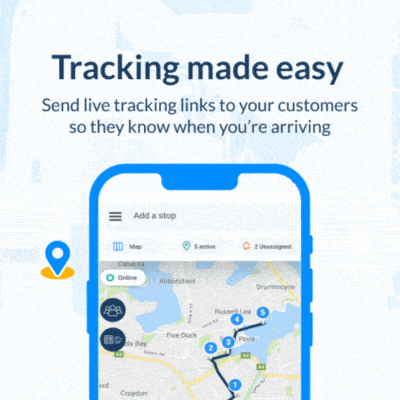When customer demand heats up, what do you do? Delivery management software helps your delivery processes become the difference between smooth operations and missed opportunities.
This technology provides you with advanced logistics solutions that streamline delivery operations across various industries.
By integrating real-time data, route optimization, and analytics, these platforms enhance efficiency and customer satisfaction in the delivery process.
For delivery companies, from fast food outlets to pet stores providing doorstep service, ensuring a seamless experience is essential.
Let’s explore five practical hacks that make delivery management smoother, faster, and ready for any level of demand.
With these tools, your logistics operations won’t just keep up; they’ll thrive in a high-demand environment.
Route optimization: Get to your delivery destination faster
Imagine it’s the peak period of the weekend, and your drivers are facing congested streets, unexpected roadblocks, and what feels like endless delivery stops.
Without a plan, this can become a mess fast. But with route optimization, you’re working with a well-calibrated tool that not only gets drivers where they need to go quickly but also helps businesses track deliveries efficiently, ensuring timely and accurate deliveries.
Here’s how it works
Route optimization considers real-time traffic, weather, and even the time it takes to make each stop, creating the shortest and quickest route for each delivery. A last mile delivery platform integrates real-time data and analytics to create the most efficient routes.
And that’s a big deal! According to the American Transportation Research Institute, traffic congestion alone costs the trucking industry a staggering $75 billion annually in lost productivity. Imagine cutting a slice of that savings by simply optimizing your routes.
Picture this: You’re managing a fleet for a pet food delivery service. With route optimization, you’re not just sending drivers out on a whim; you’re arming them with routes tailored to maximize speed and minimize fuel.
As a result, they complete more deliveries, use less fuel, and return on time.
The American Transportation Research Institute (ATRI) found that delays on the National Highway System (NHS) led to nearly 1.2 billion hours of lost productivity, using data from its truck GPS database and other sources.
Imagine cutting a slice of that savings by simply optimizing your routes.
Here’s a scenario: You’re managing a fleet for a pet food delivery service. With route optimization, you’re not just sending drivers out on a whim; you’re arming them with routes tailored to maximize speed and minimize fuel.
As a result, they complete more deliveries, use less fuel, and return on time.

Proof of delivery: How to track each delivery step
Proof of Delivery (POD) might seem minor, but it’s a powerful tool when used right.
It’s not just about collecting a signature anymore; today’s DMS gives you real-time POD capabilities with photo verification, GPS stamps, and electronic acknowledgments, allowing businesses to track deliveries and ensure accountability.
Why is this important? Because it keeps everyone accountable.
A Digital Commerce 360 study shows that 11% of packages experience a delivery issue at least once, leading to frustrated customers and costly disputes.
Having a real-time proof of delivery setup can prevent all this, providing an iron-clad record of every single delivery.
POD is a safety net for both you and the customer, ensuring that everyone knows the package made it to its destination.
Picture this: You manage deliveries for a restaurant known for its fast service. A customer calls, claiming their order never arrived.
With proof of delivery, you check the system and see a photo of the order on their doorstep, GPS-confirmed, with the time stamp. Dispute resolved.
No need for heated discussions, refunds, or unhappy reviews.

Real-time tracking: How to keep customers in the loop
There’s nothing worse than waiting for a delivery that “should be here soon.”
Real-time tracking solves this, providing transparency that benefits everyone in the chain.
Delivery management software with real-time tracking allows businesses to track deliveries and keep customers informed, giving customers peace of mind and helping your dispatch team keep tabs on all deliveries in progress.
According to Digital Commerce 360, 93% of customers want to stay updated on their deliveries.
Real-time tracking allows customers to know exactly when to expect their delivery, which can reduce calls to your team. Additionally, you gain the ability to monitor delays, adjust routes on the fly, and reassign drivers as needed.
Here’s a scenario: You’re running deliveries for a fast-casual food outlet with high order volumes around lunchtime.
Real-time tracking enables you to monitor each driver’s progress. Suddenly, one driver is held up at a construction site. You quickly reroute the other drivers to cover their area. Your orders stay on track, and your customers stay happy.

Dispatch and delivery planning: Deploy drivers accurately
Dispatching is more than just sending drivers out on the road.
With effective dispatch planning through a mile delivery platform, you can make sure your fleet is where they need to be at all times.
Think of it as a strategic approach to delivery, where each driver has their workload based on proximity, delivery urgency, and driver availability.
Picture this: You’re handling logistics for a pet supply store. Through dispatch planning, you identify which areas have the highest delivery volume.
Instead of sending drivers haphazardly across town, you allocate specific zones to drivers based on demand, ensuring a balanced workload and fewer back-and-forth trips.
Drivers are happier, delivery times are faster, and your customers benefit from more consistent delivery windows.
Data insights: Learning from every delivery
One often-overlooked feature of DMS is the wealth of data it captures. A last mile delivery platform gathers and analyzes this data to provide valuable insights for improving logistics strategies.
Every route, every stop, every delay—it’s all information that can help your logistics team improve for the future.
Delivery management software gathers this data, allowing you to analyze patterns, identify bottlenecks, and fine-tune your logistics strategy.
Here’s a scenario: After reviewing last month’s deliveries for a pet food outlet, you notice a pattern: certain times of the day consistently face delays.
Armed with this insight, you adjust your scheduling, sending out drivers 30 minutes earlier to cover these hot spots. Now, those delays are a thing of the past, and your fleet’s efficiency is at an all-time high.
Locate2u has delivery management software that can help you streamline your delivery process.
Let’s recap: Making the most of delivery management software
If you’re in logistics, Delivery management software is your go-to tool for managing the pressure.
From route optimization to proof of delivery, real-time tracking, dispatch planning, and data-driven insights, each feature builds a more efficient, more reliable delivery operation.
A comprehensive last mile delivery platform integrates these features to streamline delivery operations across various industries, enhancing efficiency and customer satisfaction.
And remember, the more you use these tools, the more you’ll uncover areas to improve, making each delivery a smoother experience for both your drivers and your customers.
Photo Credit: Canva
Share this article
About the author
Sharl is a qualified journalist. He has over 10 years’ experience in the media industry, including positions as an editor of a magazine and Business Editor of a daily newspaper. Sharl also has experience in logistics specifically operations, where he worked with global food aid organisations distributing food into Africa. Sharl enjoys writing business stories and human interest pieces.














